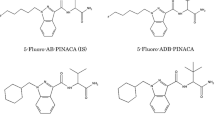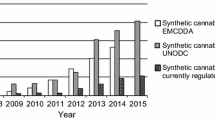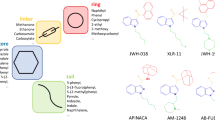Abstract
The most frequent form of consumption of cannabinoid receptor agonists (CRAs), often referred to as synthetic cannabinoids, is smoking of herbal mixtures often obtained via the Internet. However, because the plant material is either sprayed with or soaked in a drug solution, one of the main health risks in using these products is made up by the inhomogeneity in the content of active ingredient(s) and distribution within the mixtures. In the present study, 311 herbal mixtures covering 31 different brands seized from an online retailer in 2012 were analyzed quantitatively by high-performance liquid chromatography with diode array detection after screening by gas chromatography–mass spectrometry. Both interpackage and intrapackage CRA content variation were investigated by sampling without prior homogenization to reflect drug user behavior. The results showed that it is impossible for the consumer to safely dose these drugs, and that two joints of herbal mixture prepared from the same package could contain significantly different amounts of the active substance. Therefore, accidental overdosing is likely to occur frequently. In some products, interpackage variability of up to 33 % [standard deviation (SD)] and intrapackage variability of up to 20 % (SD) were observed. Another major health risk is posed by the substitution of a CRA in a herbal mixture without changing the brand name. In almost all cases when such a substitution was observed, there was a pronounced difference in the binding affinities of the respective CRA without a noticeable change in the amount added to the plant material. These findings can partly explain the high number of unintended intoxications that require hospitalization after use of these drugs.
Similar content being viewed by others
Avoid common mistakes on your manuscript.
Introduction
Synthetic cannabinoid receptor agonists (CRAs) (Fig. 1), first identified in 2008 in herbal mixtures in Germany and Japan [1, 2] represent the fastest growing class of new psychoactive substances (NPS) in Europe, with 30 new compounds reported via the early warning system of the European Monitoring Centre for Drugs and Drug Addiction (EMCDDA) in 2012 [3] and 29 in 2013 [4]. A common mode of distribution of herbal products laced with these substances is the Internet, with online shops often offering a wide variety of “legal high” products. Similar to the increase in the number of identified CRAs, the number of online shops also continues to grow, with 693 shops identified in January 2012 by the EMCDDA [3]. Because the plant material is either sprayed with or soaked in a drug solution, a significant health risk arising from the use of these products is posed by the inhomogeneity of the herbal mixtures regarding the amount of active ingredient(s) per package and uneven distribution within each package [5–7]. Such variability in the product makes it impossible for consumers to safely dose these drugs, because two joints prepared from the same mixture could contain extremely different amounts of the active substance. Furthermore, the compositions of these herbal mixtures change rapidly over time, and a certain product name does not guarantee the same composition of compound(s) between batches [8].
Despite such an obvious risk, no investigation to date has been carried out on a large number of samples from one online shop to assess product variability. Most studies of these dubious products used a homogenization step prior to quantitation, and no intrapackage variability was assessed. Although homogenization is a necessary approach in a forensic chemical analysis, the results do not reflect the risk of these drugs for consumers who might be exposed to dangerous amounts upon consuming the product.
In the present study, 311 herbal mixtures covering 31 different brands seized from a single online retailer were quantitatively analyzed utilizing a high-performance liquid chromatography-photodiode array detection (HPLC-DAD) method after screening by gas chromatography–mass spectrometry (GC–MS). Following the death of a person after consuming the herbal mixture “ACME” (containing JWH-210) and the “bath salt” product “9/11” (containing 4-methylethcathinone), the aim of this study was to assess the danger of overdosing due to interpackage and intrapackage inhomogeneities of CRAs in these products.
Materials and methods
Chemicals and reagents
Formic acid (Rotipuran® ≥98 %) was purchased from Carl Roth (Karlsruhe, Germany); methanol (HPLC grade) from J.T.Baker (Deventer, The Netherlands); acetonitrile (ACN), ammonium formate (99.995 %), ethanol (analytical grade), and ethyl acetate (analytical grade) from Sigma Aldrich (Steinheim, Germany). Deionized water was prepared using a cartridge deionizer from Memtech (Moorenweis, Germany). RCS-4 [(4-methoxyphenyl)(1-pentyl-1H-indol-3-yl)methanone] was purchased from Cayman Chemical (Ann Arbor, MI, USA). AKB-48-5F, UR-144, and XLR-11 were kindly provided by Ilmari Szilvay (Finnish Customs Laboratory). AM-1220 [(1-[(1-methyl-2-piperidinyl)methyl]-1H-indol-3-yl)-1-naphthalenyl-methanone] was obtained by purification of a research chemical using thin-layer chromatography (TLC) [9], and MAM-2201 ([1-(5-fluoropentyl)-1H-indol-3-yl](4-methyl-1-naphthalenyl)-methanone) was extracted from a herbal mixture [10, 11]. All other synthetic cannabinoids, JWH-081 [(4-methoxy-1-naphthalenyl)(1-pentyl-1H-indol-3-yl)-methanone], JWH-122 [(4-methyl-1-naphthalenyl)(1-pentyl-1H-indol-3-yl)-methanone], JWH-203 [2-(2-chlorophenyl)-1-(1-pentyl-1H-indol-3-yl)-ethanone], JWH-210 [(4-ethyl-1-naphthalenyl)(1-pentyl-1H-indol-3-yl)-methanone], JWH-307 ([5-(2-fluorophenyl)-1-pentyl-1H-pyrrol-3-yl](naphthalen-1-yl)methanone), AM-2201 ([1-(5-fluoropentyl)-1H-indol-3-yl]-1-naphthalenyl-methanone), and AM-2232 [3-(1-naphthalenylcarbonyl)-1H-indole-1-pentanenitrile] were provided by the German Federal Criminal Police Office (BKA), the State Bureaus of Criminal Investigation (LKA) Baden-Württemberg and Niedersachsen, or purchased as “research chemicals” over the Internet. 1H and 13C nuclear magnetic resonance (NMR) spectroscopy, GC–MS, and TLC were used to verify the identity and purity (≥98 %) of substances not obtained as certified standards.
Samples
All investigated herbal mixtures investigated were part of a single seizure conducted in March 2012, covering a total of 4,127 packages (31 different brands) from an online shop selling “legal highs”. From this seizure, 311 packages were quantitated as an adequate sample for interpretation of the homogeneity. Furthermore, 34 packages (21 different brands) were completely analyzed (in 200-mg portions) to investigate intrapackage inhomogeneities.
Extraction of synthetic cannabinoids
Two hundred milligrams of each herbal mixture was accurately weighed into a test tube and extracted three times by addition of 2 ml of methanol and ultrasonication for 15 min; the extracts were combined and filtered through a 0.22-µm filter (Carl Roth, Karlsruhe, Germany). The filtrate was used for in-house screening by GC–MS and quantitation by HPLC-DAD as described below. In order to mimic the usual conditions of actual drug use, no homogenization was carried out prior to sampling.
Quantitation of synthetic cannabinoid receptor agonists
For quantitation, 5 µl of filtrate was transferred into an HPLC vial containing 1 ml of mobile phase B as well as 25 µg/ml of CRA AKB-48-5F as internal standard (IS) and analyzed by HPLC-DAD utilizing a Dionex UltiMate 3000 RSLC HPLC system (Thermo Fisher Scientific, Dreieich, Germany). The system consisted of an HPG-3400RS binary pump, an SRD-3600 solvent rack degasser, a WPS-3000TRS autosampler, a TCC-3000RS column compartment, and a DAD-3000RS diode array detector (DAD). Separation was carried out by a method similar to that described by Huppertz et al. [12]. Mobile phase A consisted of deionized water with 1 % ACN, 2 mM ammonium formate, and 0.1 % formic acid. Mobile phase B was ACN containing 2 mM ammonium formate and 0.1 % formic acid. Gradient elution was performed on a Kinetex C18 column (100 × 2.1 mm i.d., 1.7 µm particle size) with a corresponding guard column (both columns from Phenomenex, Aschaffenburg, Germany). Gradient elution was started with 20 % mobile phase B for 1 min, increased to 60 % B within 1.5 min, increased to 65 % B within another 1.5 min, held for 1.5 min, increased to 99 % B within 2.5 min, and held for 2 min. Starting conditions were restored within 0.2 min, and the system was allowed to re-equilibrate for 1.8 min prior to injection of the next sample. The flow rate was set to 0.5 ml/min and the injection volume was 2 µl. The autosampler tray temperature was 10 °C and the column oven temperature was 40 °C. Wavelengths of the DAD were set to 209 and 217 nm for analysis of CRAs according to the United Nations Office on Drugs and Crime manual [13]. Five-point calibration curves (1–50 µg/ml) were prepared by fortifying 1 ml of mobile phase B containing 25 µg/ml of IS (AKB-48-5F) with the corresponding amounts of CRAs. An HPLC-DAD chromatogram of one extract from a herbal mixture containing two CRAs is shown in Fig. 2.
High-performance liquid chromatography-photodiode array detection chromatogram of one extract from the herbal mixture “Manga Hot” containing 52 mg/g AM-2201 (peak 1) and 73 mg/g JWH-210 (peak 5). Peaks 2 and 3 are impurities from the HPLC system that were also present in blank samples (not shown). Peak 4 represents the internal standard AKB-48-5F
Verification of synthetic cannabinoid receptor agonists
Considering that many CRAs have similar absorption maxima, one filtrate of each CRA composition detected in the products was verified using GC–MS analysis before quantitation by HPLC-DAD. For this purpose, 4 µl of filtrate was transferred into a GC vial and evaporated to dryness under a gentle stream of nitrogen. The dry residue was reconstituted in 100 µl of ethyl acetate, and a 1-µl aliquot was injected into the GC–MS system, which consisted of a 6890 series GC with a 5873 mass selective detector, a 7638 B series injector, and used Chemstation G1701GA version D.03.00.611 software (Agilent, Waldbronn, Germany). GC–MS conditions were: injection, splitless mode; injection port temperature, 270 °C; column, HP-5-MS capillary (30 m × 0.25 mm i.d., 0.25 µm film thickness; Agilent); carrier gas, helium; flow rate, 1 ml/min; oven temperature, 100 °C for 3 min, ramped to 310 °C at 30 °C/min, and held at 310 °C for 10 min; transfer line heater and ion source temperatures, 280 and 230 °C, respectively; ionization energy, 70 eV in electron impact ionization mode. The obtained mass spectra were compared with those of the Cayman Spectral Library [14] and with spectra from an in-house library containing a wide range of CRAs.
Results and discussion
Interpackage inhomogeneity
Interpackage inhomogeneities in CRA content in the 29 products analyzed (27 brands) and those of the five representative brands are listed in Table 1 and in Fig. 3, respectively. The highest standard deviation (SD) detected was in the product “Summerlicious,” with the AM-2232 content ranging from 26 to 100 mg/g (n = 23). It is particularly concerning that the highest measured concentration (100 mg/g) was an outlier and could lead to severe intoxication in consumers who are accustomed to using an amount of drug material adjusted to the median CRA content. Considering the high receptor binding affinity of AM-2232 at 0.28 nM toward the CB1 receptor [15], this wide range is even more worrying. Interpackage inhomogeneities observed by Choi et al. [6] in five South Korean products (2–12 packages) were higher in most of the products investigated by them as compared to those of the present study.
Intrapackage inhomogeneity
The intrapackage inhomogeneity of the 34 packages (21 brands) analyzed is shown in Table 2, and intrapackage inhomogeneity of the five packages of the herbal mixture ACME is also shown in Fig. 4. Surprisingly, the highest standard deviation of 20 % was detected in a package of the product with the lowest amount of herbal material, “MNK”. This product contains JWH-210, a CRA with a very high binding affinity toward the CB1 receptor (0.46 ± 0.03 nM) [16].
Uniqueness of brand names
In 5 of the 31 brands, the CRA composition was not identical in the packages tested (Table 3). Comparing the binding affinities of the different CRAs (Table 3) detected in a particular brand, such variability can pose severe health risks to consumers. As an example, for the herbal mixture “Blaze,” one package contained JWH-307, while the another contained JWH-210, a CRA with a more than tenfold higher binding affinity toward the CB1 receptor. Despite such a large difference in binding affinity, both CRAs were added by the manufacturer in a similar percentage. Similar results were found for the most of the other brands, in which the amounts of CRAs sprayed on the plant material were similar, but the CB1 receptor affinities were up to 50-fold different. Similar substitutions were also observed by Shanks et al. [8]; however, CRA contents were not quantitated and the products might have been purchased from different vendors.
Conclusions
Based on the obtained results, we conclude that it is impossible for users of dubious herbal mixtures to accurately dose the drugs they contain, and accidental overdoses are likely to occur frequently. Another aggravating factor is the intrapackage inhomgeneity of up to 20 % (SD) in some of the products. A third major health risk is the substitution of CRAs in herbal mixtures without changing the brand name. In almost all of these cases observed; there was a pronounced difference in the binding affinities of the respective CRA without any noticeable change in the amount added to the plant material.
References
Auwärter V, Dresen S, Weinmann W, Müller M, Pütz M, Ferreiros N (2009) ‘Spice’ and other herbal blends: harmless incense or cannabinoid designer drugs? J Mass Spectrom 44:832–837
Uchiyama N, Kikura-Hanajiri R, Kawahara N, Goda Y (2009) Identification of a cannabimimetic indole as a designer drug in a herbal product. Forensic Toxicol 27:61–66
European Monitoring Centre for Drugs and Drug Addiction (2012) The state of the drugs problem in Europe, annual report 2012. Publications Office of the European Union, Lisbon
European Monitoring Centre for Drugs and Drug Addiction (2014) European drug report 2014: trends and developments. Publications Office of the European Union, Lisbon
Langer N, Lindigkeit R, Schiebel HM, Ernst L, Beuerle T (2014) Identification and quantification of synthetic cannabinoids in ‘spice-like’ herbal mixtures: a snapshot of the German situation in the autumn of 2012. Drug Test Anal 6:59–71
Choi H, Heo S, Choe S, Yang W, Park Y, Kim E, Chung H, Lee J (2013) Simultaneous analysis of synthetic cannabinoids in the materials seized during drug trafficking using GC–MS. Anal Bioanal Chem 405:3919–3963
Logan BK, Reinhold LE, Xu A, Diamond FX (2012) Identification of synthetic cannabinoids in herbal incense blends in the United States. J Forensic Sci 57:1168–1180
Shanks KG, Dahn T, Behonick G, Terrell A (2012) Analysis of first and second generation legal highs for synthetic cannabinoids and synthetic stimulants by ultra-performance liquid chromatography and time of flight mass spectrometry. J Anal Toxicol 36:360–371
Kneisel S, Bisel P, Brecht V, Broecker S, Müller M, Auwärter V (2012) Identification of the cannabimimetic AM-1220 and its azepane isomer (N-methylazepan-3-yl)-3-(1-naphthoyl)indole in a research chemical and several herbal mixtures. Forensic Toxicol 30:126–134
Moosmann B, Kneisel S, Girreser U, Brecht V, Westphal F, Auwärter V (2012) Separation and structural characterization of the synthetic cannabinoids JWH-412 and 1-[(5-fluoropentyl)-1H-indol-3yl]-(4-methylnaphthalen-1-yl)methanone using GC–MS, NMR analysis and a flash chromatography system. Forensic Sci Int 220:e17–e22
Moosmann B, Kneisel S, Wohlfarth A, Brecht V, Auwärter V (2013) A fast and inexpensive procedure for the isolation of synthetic cannabinoids from ‘Spice’ products using a flash chromatography system. Anal Bioanal Chem 405:3929–3935
Huppertz LM, Kneisel S, Auwärter V, Kempf J (2014) A comprehensive library-based, automated screening procedure for 46 synthetic cannabinoids in serum employing liquid chromatography-quadrupole ion trap mass spectrometry with high-temperature electrospray ionization. J Mass Spectrom 49:117–127
United Nations Office on Drugs and Crime (2013) Recommended methods for the identification and analysis of synthetic cannabinoid agonists in seized materials. UNODC, Vienna
Cayman Chemical (2014) Cayman Spectral library. Accessible via https://www.caymanchem.com/app/template/SpectralLibrary.vm. Accessed June 2014
Makriyannis A, Deng H (2007) Cannabimimetic indole derivates. A., US Patent No. 7,241,799
Huffman JW, Padgett LW (2005) Recent developments in the medicinal chemistry of cannabimimetic indoles, pyrroles and indenes. Curr Med Chem 12:1395–1411
Frost JM, Dart MJ, Tietje KR, Garrison TR, Grayson GK, Daza AV, El-Kouhen OF, Yao BB, Hsieh GC, Pai M, Zhu CZ, Chandran P, Meyer MD (2009) Indol-3-ylcycloalkyl ketones: effects of N1 substituted indole side chain variations on CB2 cannabinoid receptor activity. J Med Chem 53:295–315
Wiley JL, Marusich JA, Lefever TW, Grabenauer M, Moore KN, Thomas BF (2013) Cannabinoids in disguise: Δ9-tetrahydrocannabinol-like effects of tetramethylcyclopropyl ketone indoles. Neuropharmacology 75:145–154
Huffman JW, Padgett LW, Isherwood ML, Wiley JL, Martin BR (2006) 1-Alkyl-2-aryl-4-(1-naphthoyl)pyrroles: new high affinity ligands for the cannabinoid CB1 and CB2 receptors. Bioorg Med Chem Lett 16:5432–5435
Acknowledgments
The authors thank the Drug Prevention and Information Programme of the European Union (JUST/2011/DPIP/AG/3597), the German Federal Ministry of Health, and the City of Frankfurt/Main for financial support.
Conflict of interest
There are no financial or other relations that could lead to a conflict of interest.
Author information
Authors and Affiliations
Corresponding author
Rights and permissions
About this article
Cite this article
Moosmann, B., Angerer, V. & Auwärter, V. Inhomogeneities in herbal mixtures: a serious risk for consumers. Forensic Toxicol 33, 54–60 (2015). https://doi.org/10.1007/s11419-014-0247-4
Received:
Accepted:
Published:
Issue Date:
DOI: https://doi.org/10.1007/s11419-014-0247-4








